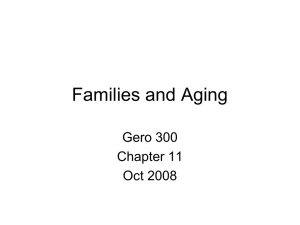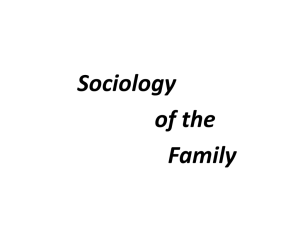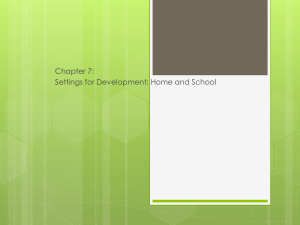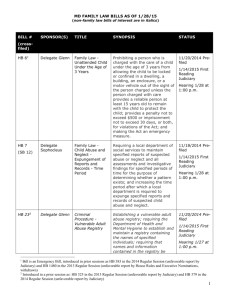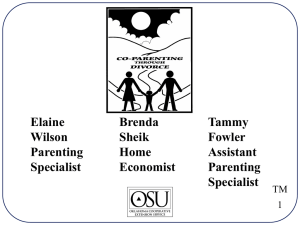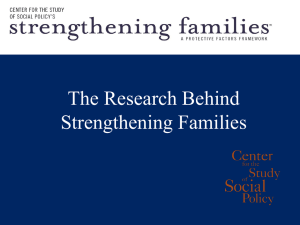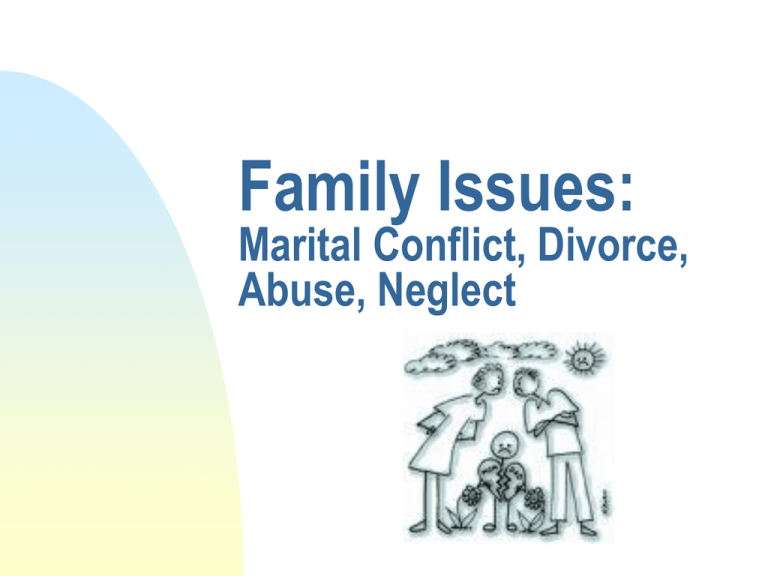
Family Issues:
Marital Conflict, Divorce,
Abuse, Neglect
Family Systems Model
Primary Assumptions
Reciprocal:
individuals shape their
environment as well as are shaped
by their environments
Dynamic: constant interactions
among individual and their
environments
Hierarchical structure: defined by
boundaries and subsystems
Bronfenbrenner’s
Ecological Model
Exosystem
Macrosystem
Microsystem
Mesosystem
Bronfenbrenner’s
Ecological Model
Microsystem: actual
settings in which the
individual experiences
day to day reality
Mesosystem:
relationships between
microsystems
Exosystem: situations that
have a bearing on child’s
development but in which
the child does not actually
play a direct role
Macrosystem: institutional
patterns and shared
assumptions of a particular
culture
Marital Conflict:
Types and Child Outcomes
Physical (Domestic Violence)
Most linked with externalizing problems in children
Traumatic symptoms
Verbal Aggression
Withdrawal (Stonewalling)
Both externalizing and internalizing problems
Most linked with depression, anxiety, and social withdrawal
in children
Mutually respectful, emotionally regulated conflict
resolution
Well-adjusted children with social problem solving skills
Other Outcomes
Childhood
Lower
academic achievement
Poorer self-concept
Poorer social competence
Adulthood
Lower
SES
Poorer self-concept
Increased marital problems
Greater likelihood of divorce
Direct and Indirect Effects
Direct
Repeated exposure to
conflict undermines
children’s capacity for
regulating their
emotional and
behavioral functioning
Indirect
Spillover hypothesis:
Impact on parenting
leading to changes in
emotional availability
(rejection, hostility) and
control (lax monitoring,
inconsistent or harsh
discipline)
Divorce: A Bad Thing?
Reading: Peris, Emery 2004
Prospective study of adolescents
in intact vs disrupted homes
Discussion
Divorce
Children’s post-divorce adjustment
affected by
Magnitude
and nature of divorce
stressors
Examples?
Interpersonal
and intrapersonal
resources
Interaction between divorce
stressors and resources
Divorce Models
Crisis
Acute stress with transition
Gradual adjustment
Protective factors/Stress buffers
Adults: education, employment, social
support
Children: active coping skills, social
support, access to therapeutic intervention
Parent-child
• Maternal Acceptance
• Consistency of Discipline
Divorce Models
Chronic Strain
Persistent long-term problems
Risk factors
Disruptions in parent-child relationships
• Inept/neglectful parenting
Continuing discord among spouses
Loss of emotional support
Economic hardship
Negative life events (moving, changing
schools)
Coping with Divorce
Components of Effective Treatments
Improve mother-child relationship quality
Praise,
Reflective listening
Positive activity scheduling
Improve effective discipline
Structure and consistency
Logical consequences
Decrease physical punishment
Co-parenting: Increase father’s access to
child
Reduce interparental conflict
Co-parenting
People who separate but continue
to work cooperatively as parents
Respectful
(no criticism)
Resolve conflicts privately
Discuss major issues together and
arrive at mutual understanding
before speaking with children
Don’t make child “confidant”
Don’t make child “messenger”
Co-parenting
Points to consider
Be clear that divorce is final and NOT
child’s fault
Remember to problem-solve
Education
Visitation schedule
Finances
Medical needs
Discipline
Holidays/special events
Not recommended for all families
Coping with Divorce
Components of Effective Treatments
Coping skills training
Emotion labeling and expression
Positive cognitive reframing to reduce
negative thoughts about divorce stressors
Effective communication “I” messages
Interpersonal problem solving
Identify ways to find social support
Child Abuse and
Neglect
Florida Statute - Chapter
415: Definitions
Sexual Abuse
Any
penetration, no matter how
slight by penis or any object
Any sexual contact of any genital
area by person’s genitals, mouth,
tongue, hand, etc.
Intentional masturbation
Sexual exploitation (engaging in
sexual acts or prostitution)
Florida Statute - Chapter
415: Definitions
Mental Injury/Emotional Abuse
Injury
in intellectual or
psychological capacity as
evidenced by a discernable and
substantial impairment in person’s
ability to function within the normal
range of performance
Physical Harm
Acts
including punching, beating,
kicking, biting, burning, and
shaking
Correlates of Child
Abuse
Parents have little exposure to positive
parental models and support
Greater degree of stress in family
environment
Information processing disturbances may
cause parents to misperceive child’s
behavior or intent
Lack of awareness of developmentally
appropriate expectations
Conflict and marital violence
Sequelae of Child Abuse
Emotional
Anxiety and
depression
Low self esteem
Increased
anger/conflict
Guilt and Shame
Social
Withdrawn
Inappropriate
sexual behavior
Vulnerability for
re-victimization
Behavioral
Runaway
behavior
Self destructive
behavior
Substance abuse
Physical
Medical problems
Somatic
complaints
Injuries
Mediating Factors of Child
Abuse
Age
of child
younger
children are more vulnerable and have not
developed good coping skills, however, older
children are more aware of social stigma
associated with abuse
Psychological
condition of victim
child
with prior emotional problems or an unstable
home environment may experience more
pronounced problems
Not
being believed or supported
especially
from others they trust
Mediating Factors of Child
Abuse
Stranger
vs. Known person
more damaging effects if assaulted by a trusted
person
Sexual knowledge or experience
child with no prior sexual experience may be more
vulnerable
Type of assault
amount of bodily harm or penetration;
does child belief body has been damaged?
Repeated assaults
more harm of repeatedly being abused
Mediating Factors of Child
Abuse
Therapy
more
likely to recover if they have individual therapy
and when they are ready, support group
Child Neglect
Physical: inadequate attention to
clothing, food, and health care
needs
Emotional: inadequate attention to
child’s emotional and
developmental needs
Educational: failure to enroll a child
in school in violation of state law,
permitting chronic truancy, or
refusing to allow needed attention
to a diagnosed educational
problem
Correlates of Child
Neglect
Poverty – *most significant
Unemployment
Housing
instability
Single parenthood
High risk neighborhoods
Household crowding
Correlates of Child
Neglect
Family interaction style and stability
Lack of affect/apathetic
Impulsive parents with poor planning and
organization
Lack of knowledge about childrearing
Social isolation
Conflict
Infrequent and critical parent-child
interaction
Children with medical or developmental
problems
Sequelae of Child
Neglect
Emotional
Insecure
attachment
Low self esteem
Increased
anger/conflict
Impaired
development
due to lack of
stimulation
Poor academic
success
Social
Passive
Withdrawn
Aggressive with
peers
Cognitive
Physical
Medical
problems
Malnutrition
Resiliency and
Adaptation
Positive relationship with at least
one important and consistent
person who provides support and
protection
Positive self-esteem and sense of
self
Prevention and
Treatment
Early prevention is key!
However, difficult if parents cannot
acknowledge maltreatment
Parent and family focused interventions
Training in child rearing
Stress management
Address anger patterns/distorted beliefs
Address parenting expectations
Household management skills
Prevention and
Treatment
Interventions for Children
Address
child’s need for safety
Emphasize emotional expression
Address cognitive distortions
regarding “world as a scary place”
Stay tuned…PTSD lecture
Other Family Issues
Siblings
Stepfamilies
Single Parent Families
Maternal Employment
Gay/Lesbian Parents
Adoption




